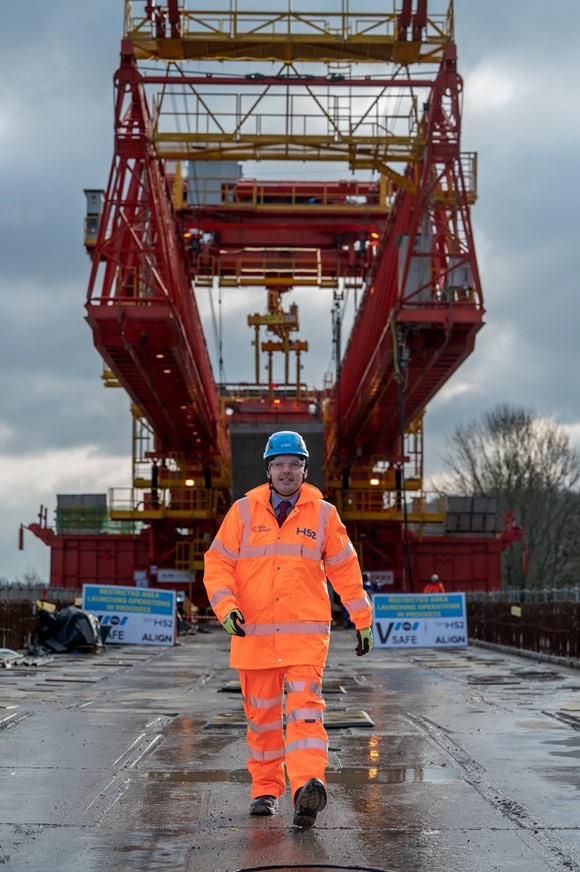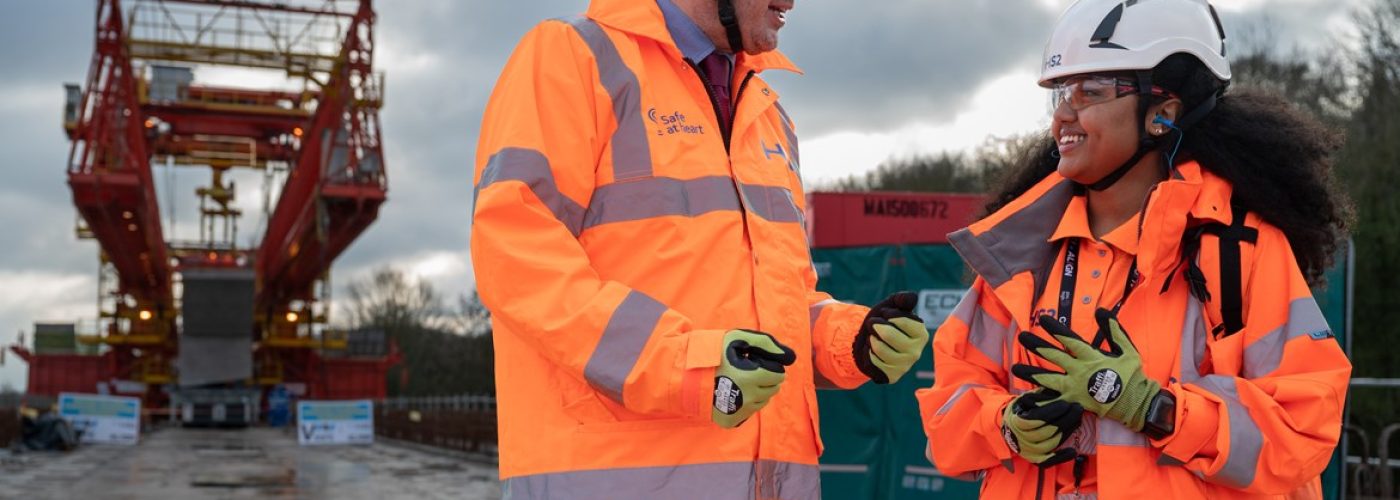HS2 minister Huw Merriman today became the first person to officially walk on top of the UK’s longest railway bridge, which is under construction at an HS2 site just outside London.
The first 480m of the Colne Valley Viaduct – which will eventually stretch for more than two miles (3.4km) across a series of lakes and waterways outside Hillingdon – have been built over the last seven months using an enormous 700 tonne ‘bridge-building machine’.
Construction of the HS2 project, which is designed to improve rail links between London, Birmingham and the North, help level-up the economy and provide a low carbon alternative to car and air travel, is ramping up across the UK with almost 30,000 jobs now supported by the project.
Rail Minister Huw Merriman said:
“This is an extraordinary feat of engineering and architecture, designed to enable spectacular views across a beautiful part of our British countryside which is being preserved and protected by this project.
“It was incredible to be the first person to officially walk on top of it today – another milestone for this monumental project which will transform journeys for people up and down the country, creating almost 30,000 jobs and providing a low carbon alternative to cars for decades to come.”
Known as a ‘launching girder’, the 160m long bridge-building machine is the only one of its kind operating in the UK and is used to lift the giant concrete deck segments that form the viaduct’s arches into position. Once each section is complete, the machine inches itself forward to build the next stage.
The first 141 – out of a thousand – deck segments are now in position, with each one weighing up to 140 tonnes. To allow for the gentle curves of the viaduct as it crosses the valley, all the segments are slightly different shapes and made on site at a purpose-built temporary factory close to the north abutment.
Welcoming the milestone, HS2 Ltd Project Client David Emms said:
“After seven months of hard work, it’s great to be able to finally be able to walk on part of the Colne Valley Viaduct. Once complete, this record-breaking structure will form a key part of the HS2 route – helping to deliver better connections across the UK, free up rail capacity on the existing train network, and offer passengers zero carbon travel options.
“I’d like to thank all those involved in getting us to this exciting stage and look forward to seeing the whole viaduct come together over the coming years.”
The huge viaduct project is being led by HS2’s main works contractor Align JV – a team made up of Bouygues Travaux Publics, Sir Robert McAlpine and VolkerFitzpatrick.
Originally built in 2004, the launching girder was first used during the construction of the Hong Kong East Tsing Yi Viaduct. Specially designed to handle complex viaduct construction, the machine is named ‘Dominique’ in memory of Bouygues engineer Dominique Droniou who played a leading role in its design and development.
Align Project Director, Daniel Altier, said:
“The team at Align, along with supply-chain partners VSL, Kilnbridge, KVJV, VolkerStevin, Tarmac, Sendin andVaughan Plant Haulage, have worked incredibly hard to get us to this point. They have demonstrated exceptional teamwork and expertise and I’m incredibly proud of what they have achieved so far. In particular, the successful completion of the A412 crossing which involved collaboration with multiple stakeholders to minimise disruption to our local community.”
56 piers each weighing around 370 tonnes are being constructed along the Colne Valley ahead of the girder, with the machine moving from one pier to the next, installing the deck segments as it goes.
Segments are placed alternately on each side of the pier, using a cantilever approach to balance the structure, as two half-arches are constructed simultaneously. Steel tensioning cables are then threaded through the segments to strengthen the bridge.
The viaduct pre-cast factory where the one thousand segments are made uses a ‘match-casting’ technique. This approach – where each segment is poured against the previous one – will ensure the whole deck fits perfectly when assembled on the piers. Up to 12 segments a week can be cast at the mammoth 100m long factory, which has an internal volume of 105,000 cubic metres – making it larger than the Royal Albert Hall.
Once construction is complete, the factory and surrounding buildings will be removed and the whole area between the viaduct and the Chiltern tunnel will be transformed into an area of chalk grassland and woodland as part of HS2’s ‘green corridor’ project.
The design of the Colne Valley Viaduct was inspired by the flight of a stone skipping across the water, with a series of elegant spans, some up to 80m long, carrying the railway around 10m above the surface of the lakes, River Colne and Grand Union Canal. Set low into the landscape, wider spans will carry the viaduct crosses the lakes, with narrower spans for the approaches. This design was chosen to enable views across the landscape, minimise the viaduct’s footprint on the lakes and help complement views across the natural surroundings.

Building, Design & Construction Magazine | The Choice of Industry Professionals





